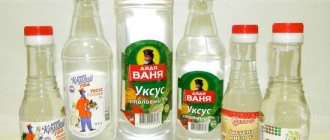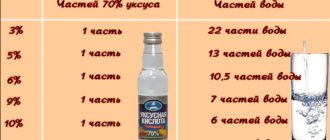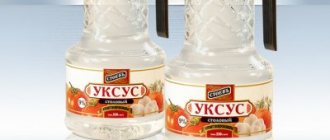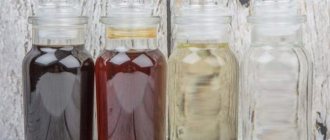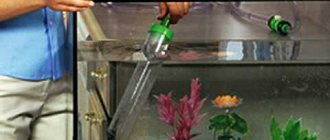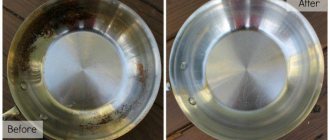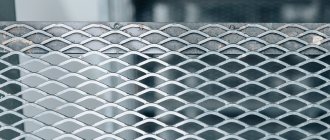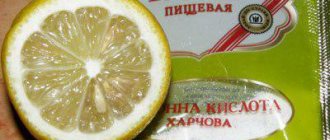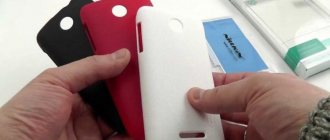How to make solutions of various concentrations at home
0
Source:
See all photos in the gallery
Concentrated vinegar 70% can be easily diluted with plain water. It’s easy and quick to make table vinegar of various strengths yourself at home, but you need to know the proportions of water and the ratio of acetic acid and essence to it. There is a simple way to make 9 percent vinegar from 70 percent vinegar. To get 9% vinegar, add two tablespoons of 70% vinegar to a faceted glass of water. Agree, with a glass on hand it is easier to dilute and understand how to dilute the 70% essence.
0
Source:
It is important to use vinegar diluted in a glass of water for its intended purpose. By following the clear instructions of the recipe, you will be able to protect yourself from the dangerous effects of undiluted acetic acid on the human body. There is a formula for diluting vinegar, but with its help you need to do the calculations yourself. For convenience, we suggest using a hint on how much water and essence you need to take:
0
Source:
By combining 1 part acid and 6 parts water, we get a 10% vinegar solution. How to dilute 70 vinegar to 9 percent? To obtain the required concentration, use a ratio of 1:7. To obtain 8 percent vinegar, mix 1 part vinegar with 8 parts water. For a 7% solution, a ratio of 1:9 is suitable. How to dilute vinegar 70 to 6? To get a 6% vinegar concentration, mix water and acid in a ratio of 11:1. Acetic essence and water in a ratio of 1:13 produces a 5% vinegar solution. Vinegar with a concentration of 4% is made from 17 parts water and 1 part acid. A 3% vinegar solution consists of 22.5 parts water and 1 part 70% vinegar essence.
Other dilution schemes
In some cases, cooks need to use vinegar of a different concentration. In this situation, you should act according to a similar scheme. For example, for a 4% solution, the following proportions must be used:
- 1:7 if 30%;
- 1:17 if the essence is 70%.
Accordingly, to create a 5% vinegar solution, the proportions will be equal:
- 1:6 (at 30% of the original essence);
- 1:13 (at 70% essence).
For a 6% solution:
- 1:5 (at 30% of the initial concentration);
- 1:11 (at 70% of the original concentration).
For a 7% solution:
- 1:4 (at 30% of the initial concentration);
- 1:9 (at 70% of the original concentration).
For 8%o solution:
- 1:3.5 (at 30% of the initial concentration);
- 1:8 (at 70% of the original concentration).
For a 9% solution:
- 1:3 (at 30% of the initial concentration);
- 1:7 (at 70% of the original concentration).
So, now you know how to dilute vinegar at home and properly use it in preparing delicious baked goods and marinades.
Acetic essence is a solution consisting of 20% water and 80% concentrated acetic acid. According to organoleptic indicators, it is a colorless liquid with a sharp, specific odor and sour taste.
Food vinegar essence is obtained not by combining acid with water, but by distilling 5% vinegar, which is formed naturally when wine sours. Pure acid can only be removed chemically by treating acetates with sulfuric acid.
Curious!
100% acetic acid is called glacial acid because when cooled to 17 ° C it turns into ice-like crystals.
In home cooking, we most often encounter not the essence itself, but its aqueous solution from 3 to 13%, known as table vinegar. However, for the preparation of some marinades and canned products, a 70% acid solution is required. What to do if you don’t have it at hand? Is it possible and, if so, how can I replace vinegar essence with 9% vinegar?
Calculation of proportions
0
Source:
To correctly answer the question of how to dilute 70 vinegar to 9%, you should know that the presented product is divided into two types. In other words, it can be synthetic and natural. The latter seasoning is obtained as a result of long fermentation of various liquids that contain alcohols. Thus, there are apple, wine, and berry vinegars, as well as those infused with herbs and leaves of fruit bushes. As for synthetic vinegar, the main ingredient in it is acid. As a rule, it is obtained through chemical processes. They are often based on natural gas, wood distillation products, as well as some by-products obtained in industry.
0
Source:
Of course, ideally you should only eat natural vinegar. But synthetic ones can be safely used for household needs (for example, removing various stains, disinfecting, etc.). So, if you need to get highly concentrated table vinegar, then the essence should be diluted as follows: to get 30% table vinegar - 1.5 parts of ordinary drinking water; to obtain 10% table vinegar - 6 parts of ordinary drinking water; to obtain 9% table vinegar - 7 parts of ordinary drinking water; to obtain 8% table vinegar - 8 parts of ordinary drinking water; to obtain 7% table vinegar - 9 parts of ordinary drinking water. We suggest you read: How much and how to cook chicken eggs correctly
0
Source:
If you need to make low-concentrated table vinegar, then the 70% essence must be diluted in the following proportions: to obtain 6% table vinegar - 11 parts of ordinary drinking water; to obtain 5% table vinegar - 13 parts of ordinary drinking water; to obtain 4% table vinegar - 17 parts of ordinary drinking water; to obtain 3% table vinegar - 22.5 parts of ordinary drinking water.
The most popular vinegar solutions
It is better to use different types of vinegar for different purposes. There is natural vinegar, obtained by fermenting fruit and berry juices, and there is synthetic vinegar, obtained by distilling wood, oil, and gas.
The cost of natural vinegar is much higher, and so is its taste, so for cooking it is better to use natural varieties, but synthetic varieties are quite suitable for cleaning kitchen surfaces and removing stains.
| Item no. | Area of application of the solution | Permissible concentration |
| 1. | Cleaning the kitchen stove from grease, removing rust | 30% |
| 2. | Disinfection and stain removal from fabric surfaces | 10% |
| 3. | Marinades for long-term storage in hermetically sealed jars | 9% |
| 4. | Quick marinating of meat and onions | 8% |
| 5. | Quick vegetable marinades that do not require hermetically sealed without long-term storage | 7% |
| 6. | Extinguishing soda for baking flour products | 6% |
| 7. | Removing odors from lunch boxes, bread bins, refrigerators | 5% |
| 8. | Independent seasoning for boiled and fried meat (pork) | 4% |
| 9. | Dressing fresh vegetable salads, preparing homemade mayonnaise | 3% |
How to dilute 9 percent vinegar to 6 percent and 3%
Diluted 9% vinegar often needs to be diluted to 6% or 3%; in other words, the existing 9% solution needs to be diluted. When diluting 9 percent vinegar, you can measure the liquid in milliliters or make calculations in grams. If you dilute two glasses of 9% vinegar with a glass of water, you get 6% table vinegar. Following this formula, it is easy to answer the question of how to dilute 9 percent vinegar to 3 percent, or how to make 6 percent vinegar from 9 percent. To dilute 70% acetic acid into solutions of other percentages, water will be required in certain proportions. You can find out how to dilute 70 percent vinegar from a convenient table.
Acetic essence 70% converted to 9% vinegar: table
Before looking for information on converting 70% acetic acid into 9% vinegar, pay attention to the vinegar dilution table with ready-made calculations on how to make 9% vinegar from 70% vinegar. A table of the concentration of vinegar 70% and the ratio of one part of it to parts of water will help you independently obtain a correctly diluted solution: Example: 3% vinegar is obtained from 1 part vinegar and 22 parts water; 4% – 1:17; 5% – 1:13; 6% – 1:11; 7% – 1:9; 8% – 1:8; 9% – 1:7; 10% – 1:6; 30% – 1:1.5; 40% – combine with 0.8 part of water.
Precautionary measures
Simple safety rules should be followed when storing and diluting 70% vinegar essence:
- Store the essence only in industrial packaging with a label! Essence manufacturers specifically use non-standard bottles so that the product cannot be confused with anything else;
- keep the essence out of the reach of children;
- when diluting essence, be sure to pour the essence into water, and not vice versa;
- Do not lean over the solution, so as not to burn your respiratory tract with acetic acid vapor when mixing.
How to make nine percent vinegar
Table vinegar of this concentration is used for canning food. How to dilute vinegar essence to obtain a solution with a concentration of 9%? It is necessary to dilute the essence with 70% water in the ratio: 1 part concentrate and 7 parts water. That is, for 0.5 liters of water you need to add 75 ml of essence (one and a half shot glasses). A solution of table vinegar is recommended to be used as a rubdown for diseases accompanied by an increase in body temperature. How to dilute vinegar essence at temperature? Pour one liter of water into an enamel bowl and add 2 tbsp. l. 9% table or apple cider vinegar. Six percent table vinegar is added to meat marinades. How to dilute vinegar essence: 10.5 parts water to 1 part concentrate. To obtain 0.5 liters of solution, take 45 ml of essence (three tablespoons). Table vinegar with a concentration of 3% is used to season ready-made dishes: salads, dumplings, pickled mushrooms, onions, sauces, etc. How to properly dilute vinegar essence and get a three percent solution: take 22 parts of water for one part of the essence. To prepare 0.5 liters of table vinegar you need 20 ml of vinegar essence 70%. Dilute the essence in a glass or enamel container. First, the required amount of clean drinking water is measured into it. The water should be cool. Then add the calculated amount of vinegar essence. Avoid contact of the concentrate with the skin and especially with the mucous membranes of the eyes and mouth. But if such a nuisance does occur, rinse the affected area under cool running water. We suggest you read where acetic acid is used
Precautionary measures
Simple safety rules should be followed when storing and diluting 70% vinegar essence:
- Store the essence only in industrial packaging with a label! Essence manufacturers specifically use non-standard bottles so that the product cannot be confused with anything else;
- keep the essence out of the reach of children;
- when diluting essence, be sure to pour the essence into water, and not vice versa;
- Do not lean over the solution, so as not to burn your respiratory tract with acetic acid vapor when mixing.
In what cases is it necessary to dilute vinegar?
0
Source:
At home, acetic acid is often used in cooking and as a traditional medicine. In diluted form, it is used externally to treat joints, heel spurs, and reduce elevated body temperature with vinegar compresses. For cosmetic purposes, a low concentration solution is used to rinse hair. The vinegar solution is used to wipe the skin of the face and body; people drink apple cider vinegar to lose weight. Diluted vinegar is included in mixtures against pests of cabbage, currants and indoor plants. The vinegar solution has an effective effect on tomatoes; gardeners use it to prevent late blight, against aphids on cucumbers, and to treat bell pepper ovaries against pests. If you dilute vinegar correctly, its solution is suitable for any purpose. Vinegar inherently has a wide range of applications; it is used for various purposes. The sour-tasting solution serves as an indispensable seasoning for dumplings. Diluted and undiluted 70% vinegar is added as a preservative for preparing homemade squash caviar for the winter, when marinating champignons in jars, wild mushrooms for future use and vegetables. As the main ingredient, vinegar can be found in almost all recipes for marinades of cabbage, meat kebabs with onions, and preparing sushi rice.
The most popular vinegar solutions
It is better to use different types of vinegar for different purposes. There is natural vinegar, obtained by fermenting fruit and berry juices, and there is synthetic vinegar, obtained by distilling wood, oil, and gas.
The cost of natural vinegar is much higher, and so is its taste, so for cooking it is better to use natural varieties, but synthetic varieties are quite suitable for cleaning kitchen surfaces and removing stains.
| Item no. | Area of application of the solution | Permissible concentration |
| 1. | Cleaning the kitchen stove from grease, removing rust | 30% |
| 2. | Disinfection and stain removal from fabric surfaces | 10% |
| 3. | Marinades for long-term storage in hermetically sealed jars | 9% |
| 4. | Quick marinating of meat and onions | 8% |
| 5. | Quick vegetable marinades that do not require hermetically sealed without long-term storage | 7% |
| 6. | Extinguishing soda for baking flour products | 6% |
| 7. | Removing odors from lunch boxes, bread bins, refrigerators | 5% |
| 8. | Independent seasoning for boiled and fried meat (pork) | 4% |
| 9. | Dressing fresh vegetable salads, preparing homemade mayonnaise | 3% |
